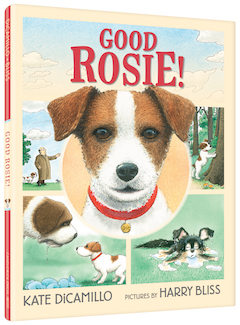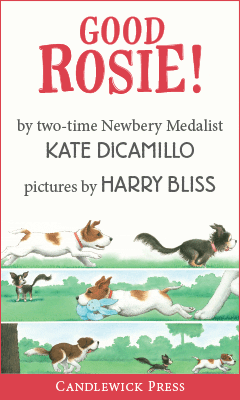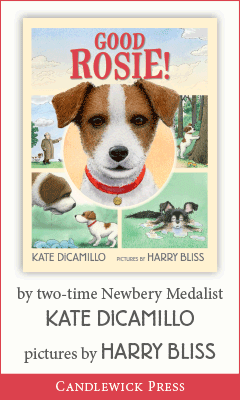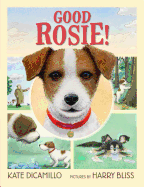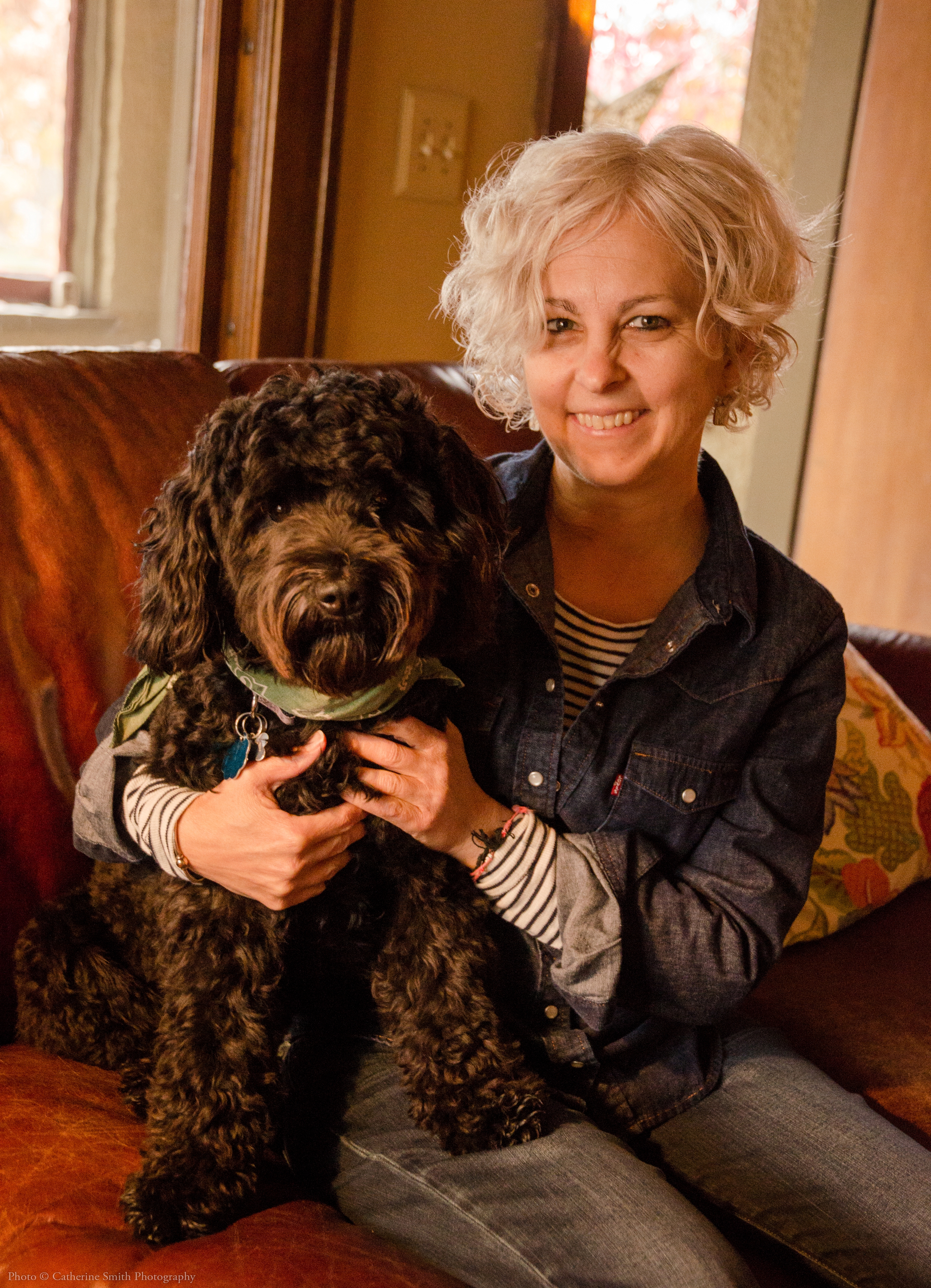Good Rosie!
by Kate DiCamillo, illus. by Harry Bliss
Author/illustrator duo Kate DiCamillo and Harry Bliss triumph again with Good Rosie!, a comic-format picture book about finding (and making) new (doggie) friends.
"Rosie is a good dog." The Jack Russell Terrier lives with a man named George and has a nice, predictable routine: they get up in the morning and eat two poached eggs (George) and kibble from a silver bowl (Rosie). After breakfast they take a walk and look at clouds. "George thinks that most clouds look like presidents. Rosie thinks that most clouds look like squirrels." This life is pleasant, but Rosie is a bit lonely. Every morning when she finishes her kibble she sees the reflection of "another" dog staring back at her. "Hello!" ("Ruff!") she says. Alas, the other dog never answers.
When George announces they are going to try something new, Rosie is curious but wary. She is, after all, a creature of habit. And when this "something new" turns out to be a visit to a dog park, Rosie is pretty sure she's not interested. "Rosie does not like the dog park. There are too many dogs. She doesn't know any of them. It makes Rosie feel lonely to look at so many strange dogs. And a little bit afraid." A huge St. Bernard with a blue plush toy approaches her: "My name is, uh, Maurice," he says. "And I have a bunny." He tries to entice Rosie to play by shaking his stuffed bunny. "He shakes it very, very hard." Rosie, not impressed, is a little nervous. "I want to go home," she tells George, although it comes out as "Woof!"
Next a tiny "something"--a Chihuahua?--bounces toward Rosie. She's "a very small dog with a very sparkly collar" and she seems very pleased to meet Rosie. "I'm Fifi! I'm Fifi!" she yips. "It says Fifi right on my collar! See? My name is spelled out in shiny stones." A full-page panel shows giant Maurice holding his bunny down, preparing to pounce, and Fifi leaping into the air, barking. Rosie hides under a bench, looking forlorn.
A near-disastrous attempt by Maurice to play with Fifi finally breaks the awkward dynamic among the threesome, as Rosie discovers that Maurice, in spite of his size, is vulnerable and Fifi, in spite of her size, is brave and strong. None of them has a clear idea of how to make friends. But Fifi, who has lost three of the shiny stones on her collar in the melee, rendering her name "Fif," simply asks Rosie: "Do you want to be friends with a dog named Fif?" and Rosie, to her surprise, does. "That's how you make friends," Fif tells Maurice.
We've all been there. Making new friends can be uncomfortable. In its quiet, measured way, Good Rosie! expresses all the ambivalence and hopefulness of new encounters, as well as the comical aspects of good intentions gone terribly, ridiculously wrong. Young readers will easily relate to the various dog-park befriending techniques, having likely seen--and participated in--them all on their own playgrounds already. The hard-won friendship among the three pooches will delight readers of all ages, who will sense from the start that there is not a single "bad dog" in the bunch, first impressions notwithstanding.
DiCamillo and Bliss, who previously teamed up on the marvelously quirky Louise, The Adventures of a Chicken, are a fantastic creative duo. DiCamillo's expressive, humorous dialogue both entertains and touches the reader with an implicit undercurrent of humanity, even though the protagonists are canines. DiCamillo is an authorial animal whisperer, as evidenced in her two Newbery Medal winners, The Tale of Despereaux and Flora & Ulysses, and her Newbery Honor book, Because of Winn-Dixie. The voices of the three dogs are priceless, reflecting each of their natures: unquenchably enthusiastic Fifi/Fif; big, drooling, slightly clueless Maurice; and Rosie, who is a little bit sad and a little bit shy.
Bliss, who is well known for both his children's book illustrations (Bailey; A Fine, Fine School; Diary of a Worm; My Favorite Pets) and his cartoons, which appear frequently in the New Yorker, has a masterful way with dog illustrations. The personalities and expressions of Rosie, Fif(i) and Maurice are vividly familiar, as though they are real dogs we already know. The illustrations are set up in a graphic storybook format, with panels that change size and format to help pace the narrative; scenes are uncrowded, allowing readers plenty of space and time to sit with the story.
The panels in which Rosie meets Maurice, for example, capture to perfection her bemusement at the entire situation. Her head tilts upward a fraction of an inch per panel to take in Maurice's massive jowls, of which we only see a small portion in the upper left corner. Echoing that scene a few pages later is the one in which Rosie meets Fifi. All that can be seen in the first two panels are a pair of legs bounding out of the frames, with Rosie's head following their trajectory like a ball in a tennis match. In the third panel, Fifi has landed, pleased, in front of Rosie, who remains silent and unmoved. The moment when Rosie realizes she might actually like Fifi "[j]ust a little bit" is when Fifi models a tenacity and spiritedness that allows her to rise up out of a pool of Maurice's drool seconds after having been shaken to within an inch of her wee life: "Her collar sparkles. Her legs tremble. She holds her tiny heard up high and says, 'I'm Fifi and I'm alive!' "
And a new morning routine begins, in which "Rosie walks away from her bowl without looking back," lonely no more. Fif and Maurice wait for Rosie at the park where "Rosie chases Fif. Maurice chases Rosie. They run very fast." And, sometimes, they happily "catch each other." Readers will celebrate all three dogs' dogged commitment to finding their pack. --Emilie Coulter



